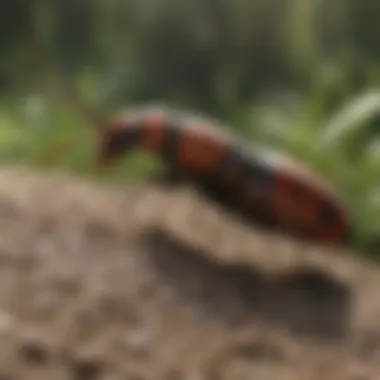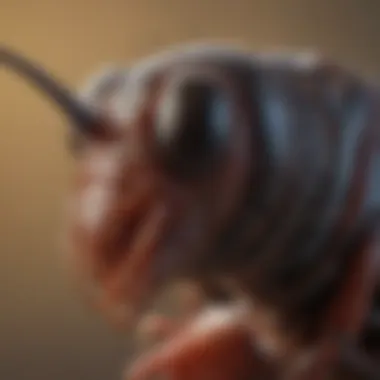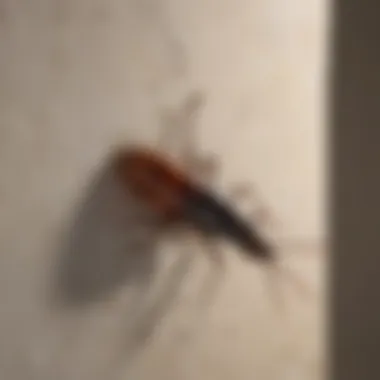Understanding Earwigs: Behavior and Prevention


Intro
Earwigs are often met with unease when they unexpectedly find their way into homes. Despite their somewhat ominous reputation, these insects exhibit a range of behaviors and preferences that can help homeowners manage their presence effectively. This article seeks to illuminate the world of earwigs, discussing their identification, habitat, and what attracts them to residential spaces. By providing practical strategies for prevention and treatment, we aim to dispel common myths surrounding these creatures, empowering homeowners with the knowledge needed to tackle infestations.
Pest Identification
Detailed descriptions of common pests
Earwigs, particularly the European earwig Forficula auricularia, are the most common species encountered indoors. They typically measure between 5 to 25 mm in length and are easily recognized by their distinctive pincers, which are used for defense and mating rituals. They have slender bodies that are usually brown or reddish-brown, with long antennae.
While earwigs are the primary focus, it is useful to differentiate them from other household pests. Common insects like cockroaches and silverfish can also invade homes, but their behaviors and appearances differ significantly.
- Cockroaches: Usually larger and have a flatter body, varying from brown to black colors. Their movement is fast and erratic.
- Silverfish: Characterized by a silvery body with a wriggling motion. They prefer dark, damp areas.
Signs and symptoms of infestations
Identifying an earwig infestation can be straightforward. Common indicators include:
- Finding earwigs in dark, moist areas such as basements, bathrooms, or kitchens.
- Noticing droppings that resemble small black specks.
- Observing damage to plants or organic materials, as earwigs may feed on decaying vegetation.
If there are visible signs of their presence, it is advisable to take preventive measures to avoid larger infestations in the future.
Prevention Strategies
Home maintenance tips for pest prevention
Preventing earwigs from entering your home starts with some basic maintenance practices. Consider the following tips:
- Seal Entry Points: Inspect for cracks and gaps around windows, doors, and foundations. Use caulk or weather-stripping to seal them.
- Reduce Moisture: Earwigs are attracted to damp environments. Ensure proper drainage and check for leaks or standing water.
- Maintain Landscaping: Trim back plants and establish a distance between mulch and the foundation of your home. This reduces a habitat for earwigs.
Natural deterrents and barriers
Several natural methods can deter earwigs effectively:
- Essential oils: Mixing water with essential oils such as peppermint or tea tree can create a spray to repel them.
- Diatomaceous earth: This natural substance can be sprinkled around entry points and will deter earwigs upon contact.
By implementing these preventive strategies, the chances of an infestation can significantly decrease, making homes less inviting to these insects.
Treatment Options
Overview of chemical vs. natural treatments
When dealing with an earwig infestation, homeowners have various treatment options. Chemical treatments often provide rapid relief but come with health and environmental considerations. On the other hand, natural treatments are gentler but may require a longer time to see results.
- Chemical Treatments: Insecticides containing pyrethrins can be effective. Always follow the instructions carefully to ensure safety.
- Natural Treatments: A combination of soap and water can be sprayed directly on earwigs. This method is less harmful to the environment and can be quite effective.
Step-by-step guides for DIY treatments
For those opting for a DIY approach, here is a simple guide:
- Locate Areas of Activity: Check under pots, in cracks, and dark corners.
- Prepare a Solution: Mix dish soap with water in a spray bottle.
- Apply Directly: Spray the solution on earwigs observed. They will die upon contact.
- Monitor the Area: Keep checking regularly to assess whether the infestation persists.


In summary, understanding earwigs involves recognizing their traits, taking preventive measures, and employing effective treatment strategies. Homeowners can maintain control over their living environment by being informed and proactive.
Prolusion to Earwigs
Understanding earwigs is crucial for homeowners as these insects can unexpectedly turn into unwelcome house guests. Despite their somewhat unsettling appearance, earwigs are often misunderstood creatures. By learning about their behavior and habitat, homeowners can better prepare for their presence and possibly prevent infestations. This section introduces the fundamental concepts necessary for a deeper understanding of earwigs and their role within residential environments.
What are Earwigs?
Earwigs are small, elongated insects belonging to the order Dermaptera. They typically measure between 5 to 25 millimeters in length. Characterized by a pair of pincers at the end of their bodies, these appendages can appear intimidating. However, earwigs are generally harmless to humans. A common misconception is that they enter human ears; however, this is not based on accurate evidence.
These insects are nocturnal and prefer to hide in dark, damp places during daylight. This behavior often leads them to crawl into homes, especially during wet seasons or after heavy rains.
The Biological Classification of Earwigs
Earwigs belong to the order Dermaptera, which derives its name from the Greek words "derma" meaning skin and "ptera" meaning wings. While some species possess wings, they rarely fly. The classification hierarchy includes:
- Order: Dermaptera
- Suborder: Caelifera
- Family: Forficulidae, Anisolabididae, and others
This classification highlights the diversity within the earwig family, with hundreds of species worldwide. Each species adapts uniquely to its environment, reflecting variations in size, coloration, and behavior.
Common Species of Earwigs
A few species of earwigs are particularly common in residential areas. Among them are:
- European Earwig (Forficula auricularia): This species is prevalent in many regions and is characterized by its long, slender body and distinctive pincers.
- Common Brown Earwig (Euborellia annulipes): Known for its brownish color, this species prefers warmer environments and is often found in garden areas.
- Striped Earwig (Labidura riparia): Easily recognized by its striped body, this species is typically found near sandy or muddy habitats.
By identifying these common species, homeowners can more easily recognize earwig presence in their homes and surroundings, enabling more effective management strategies.
Behavior and Habitat
Understanding earwig behavior and habitat is crucial for effective management and prevention of these insects in your home. Knowledge of where earwigs thrive and their patterns of movement helps you to implement practical strategies that can keep them at bay. By recognizing their behaviors, homeowners can take proactive steps to create less inviting environments, thus minimizing the chances of an infestation.
Earwig Behavior Patterns
Earwigs are predominantly nocturnal creatures. They are most active during the night, seeking out dark and damp environments during the day. This behavior inherently makes them elusive, which can complicate detection for homeowners. One common behavior is to hide in small crevices or under debris. In gardens, they might be found among fallen leaves or under stones, where moisture provides a hospitable environment.
The reproductive cycle of earwigs is significant. They tend to lay eggs in the soil or in organic matter like decaying leaves. The young emerge as miniature replicas of adults. After hatching, earwigs tend to stay close to their mothers for a short period. This maternal behavior increases the survival rate of the young, promoting local populations. Interestingly, earwigs are known for their omnivorous diet, consuming a variety of plant material as well as smaller insects. This behavior can both aid in pest control within gardens but also create issues for beneficial plants if earwig populations grow out of control.
Preferred Habitats: Where Do Earwigs Live?
Earwigs prefer environments that provide moisture and cover. They are often found in gardens, under rocks, in mulch, or even within damp cracks in foundations. Their natural habitats typically include fields, forests, and anywhere with rich organic material. In homes, they seek out damp areas such as basements, bathrooms, and kitchens.
Moreover, earwigs have been observed to invade areas with ample foliage. This behavior reflects their preference for hiding and feeding among plants. One particular earwig species, the common earwig (Forficula auricularia), is notorious for making its way indoors during periods of heavy rainfall. The combination of humidity and optimal hiding spots makes these indoor environments attractive.
Conditions that Attract Earwigs to Homes
Several factors can invite earwigs into your living space. High humidity levels are a primary motivator. Consequently, homes with leaky pipes, poorly ventilated basements, or overwatered gardens can create ideal conditions for earwigs to thrive.
In addition, the presence of food sources can attract these insects. Earwigs feed on organic matter, and this can include decaying plants and leftover food. Homes with accessible food remnants or gardens with overripe vegetables may entice earwig populations.
Preventive measures to deter earwigs include:
- Regularly cleaning damp areas in your home.
- Ensuring proper drainage in your garden.
- Keeping plant debris to a minimum around your property.
- Sealing cracks and crevices around windows and doors.


"Understanding earwig behavior and habitat provides significant insights for effective pest management strategies."
By comprehending earwigs' behavior and habitat preferences, homeowners can better implement strategies for prevention and control. This knowledge not only reduces the chance of an infestation but also promotes a healthier living environment.
Identification of Earwigs
Identifying earwigs is crucial for homeowners facing potential infestations. Understanding their unique features enables individuals to differentiate them from similar pests. This knowledge serves several benefits, such as timely intervention and effective management strategies. Knowing what to look for can prevent escalating infestations, particularly in vulnerable areas within the home.
Physical Characteristics of Earwigs
Earwigs possess distinct physical features that aid in their identification. They typically have elongated bodies, measuring around 1 to 2 inches in length. Their color ranges from reddish-brown to dark brown, providing them a good camouflage in various environments.
One of the most notable characteristics is the pair of forceps-like pincers, known as cerci, found at the rear of their bodies. Males usually exhibit larger pincers compared to females, and their size can vary based on the specific species. Additionally, earwigs have a flat, elongated body shape, which allows them to hide in small crevices.
They also have well-defined antennae, comprising eight segments. These help earwigs to sense their environment, which is essential for their nocturnal behavior. Understanding these physical characteristics not only aids in identification but also highlights aspects that may indicate an abundance of earwigs in and around your home.
Signs of Infestation
Recognizing signs of an earwig infestation is vital for prompt management. Homeowners should look out for the following indicators:
- Presence of Earwigs: Spotting these insects in common areas, especially at night when they are most active, is an obvious sign.
- Damage to Plants: Earwigs are known to feed on leaves and flowers, so any unexplained damage to garden plants may indicate their presence.
- Frass and Waste: Small droppings, often found near feeding areas, can suggest an infestation.
- Sheltering Sites: Finding earwigs in damp, dark places such as under pots, mulches, or garden debris is also a common sign.
Detecting these signs early can help in taking necessary actions before the infestation becomes severe. Homeowners are advised to routinely inspect their properties for these signs to maintain a pest-free environment.
Proper identification of earwigs and awareness of infestation signs are essential steps for effective pest management. This understanding is especially beneficial for those responsible for maintaining household environments.
Potential Risks and Myths
Exploring the potential risks and myths surrounding earwigs provides essential insights for homeowners. Many people harbor misconceptions about these insects, often leading to unnecessary fear and confusion. Understanding the truth regarding earwigs is crucial not just for addressing any concerns effectively but also for fostering a well-informed approach to pest control.
Earwigs, unlike common fears, do not pose significant harm. By educating oneself about the nature of these insects, one can differentiate between fact and fiction, reducing anxiety about their presence. In this discussion, we will dissect whether earwigs are harmful to humans and pets. We will also clarify the common myths associated with their behavior and existence.
Are Earwigs Harmful to Humans or Pets?
Earwigs are generally not harmful to humans or pets. They do not bite under normal circumstances, and their pincers, often mistaken for stingers, are primarily used for self-defense or to capture prey. In most cases, an earwig will avoid confrontation with larger beings, such as humans or pets.
Some key points to consider include:
- Non-venomous: Earwigs do not possess venom, making them harmless in terms of direct interaction with humans.
- No serious diseases: These insects are not known to carry diseases that could infect people or pets.
- Hygienic impact: While they can invade homes in search of moisture or food, their presence typically does not lead to significant contamination or health risks.
While earwigs are not a danger, it's wise to maintain a level of caution. An increase in their population might indicate underlying moisture issues or other pest concerns.
Common Misconceptions about Earwigs
Misconceptions about earwigs are quite prevalent, and they often stem from folklore and myths. Some of these myths can lead to undue alarm. Here are a few common misconceptions:
- Earwigs crawl into ears: One of the most widespread myths is that earwigs crawl into people’s ears while they sleep. This scenario is highly unlikely and often exaggerated.
- They destroy homes: Some fear that earwigs can cause significant damage to home structures. In reality, their diet consists mainly of decaying organic matter and living plants, but they typically do not harm home construction.
- Attraction to light: Many believe earwigs are attracted to light, similar to moths. In fact, earwigs tend to prefer dark, moist environments, making attics or basements more appealing than brightly lit areas.
Understanding these misconceptions not only reduces fear but also encourages effective pest management strategies.
By learning the facts, homeowners can approach earwig management with clarity, utilizing appropriate measures based on understanding rather than fear.
Prevention Strategies


Preventing earwigs from entering your home is crucial for maintaining a comfortable living environment. These insects can be more than just a nuisance; they can quickly multiply and create unsightly infestations. By understanding the prevention strategies, homeowners can minimize the chance of earwig presence, which in turn protects property value and ensures peace of mind. Compared to dealing with an infestation after it takes hold, implementing preventive measures is often simpler and more cost-effective.
How to Prevent Earwigs from Entering Your Home
- Seal Entry Points: One effective way to deter earwigs is by sealing cracks and crevices around windows, doors, and foundations. Use caulk to fill gaps and ensure that weather stripping on doors is intact.
- Maintain Cleanliness: Keeping your home tidy plays a key role. Vacuuming regularly removes potential hiding places for earwigs, such as dust, debris, and organic material.
- Reduce Moisture: Earwigs are drawn to damp areas. Fix any leaky pipes and ensure good drainage around your home. Using a dehumidifier in basements can further lower humidity levels.
- Proper Yard Maintenance: Trim vegetation near the foundation. Overgrown plants can provide shelter for earwigs and other pests.
- Use Barriers: Consider placing diatomaceous earth around the perimeter of your home. This natural substance can deter crawling insects by damaging their exoskeletons.
Environmental Changes to Deter Earwigs
Altering your home's exterior environment can also discourage earwigs from moving in. Here are some effective strategies:
- Limit Mulch: While mulch is beneficial for gardens, it can create a perfect habitat for earwigs. If using mulch, consider using inorganic types like gravel instead of organic material.
- Remove Debris: Clear debris such as leaf piles, wood piles, and other organic matter from around your home’s foundation. This minimizes potential nesting spots.
- Adjust Outdoor Lighting: Earwigs are attracted to light. Use yellow or sodium vapor lights instead of white lights in your exterior fixtures to reduce attraction.
- Control Plants: Keep plants well-maintained and monitor them for signs of infestation before they can invade your home. Look for wilted leaves or signs of earwig activity in soil.
"Prevention is better than cure." This ancient wisdom holds true in pest control. By implementing these simple strategies, homeowners can save time and resources while keeping their environments more comfortable.
Overall, these steps will not only lower the likelihood of earwigs entering your home but will also improve your outdoor space. A well-maintained property contributes to a healthier living environment for you and your family.
Treatment Options for Earwigs
Addressing earwig infestations in homes is critical for maintaining a comfortable living environment. This section outlines various treatment options available to homeowners, focusing on their effectiveness and practical considerations. Understanding these options not only empowers homeowners but also helps in making informed decisions when dealing with earwigs. Effective management can prevent potential frustrations associated with these pests and reduce their numbers significantly.
Natural Remedies for Earwig Control
Natural remedies offer an eco-friendly approach to manage earwigs without resorting to harsh chemicals. Some of the most effective natural methods include:
- Diatomaceous Earth: This powdery substance works by dehydrating the earwigs. Sprinkling it in potential infested areas helps in reducing their population.
- Essential Oils: Oils such as peppermint or tea tree can repel earwigs. Diluting these oils in water and spraying around entry points may help deter these pests.
- Soap and Water Solution: This simple mixture can be sprayed on earwigs to suffocate them. Regular application can keep their numbers under control.
Using natural remedies not only helps in addressing the immediate problem but also minimizes the ecological footprint associated with pest control.
Chemical Solutions and Pesticides
In cases where natural remedies are insufficient, chemical solutions may be necessary. These options typically offer quicker results but come with considerations:
- Granular Insecticides: Products such as Ortho Bug B Gon contain ingredients specifically targeting earwigs. Applying these around the perimeter of your home can create a barrier.
- Sprays: Ready-to-use sprays can be directly applied to infested areas or entry points. It is crucial to follow the instructions carefully to ensure safety and effectiveness.
- Bait Stations: These are designed to attract and kill earwigs. They provide a targeted approach to reduce the population effectively.
When utilizing chemical solutions, always consider the safety of children and pets in the household.
Professional Pest Control Services
For persistent infestations, engaging professional pest control services can be the most effective approach. These experts can provide methods tailored specifically to the specific conditions in your home. They often utilize strategies like:
- Integrated Pest Management (IPM): This holistic approach combines various methods for long-term control. It takes into account the lifecycle and behavior of earwigs to minimize their recurrence.
- Targeted Treatments: Professional services can apply stronger treatments that may not be available to the public. This often results in faster and more thorough elimination of pests.
- Monitoring: Many services provide follow-up monitoring to ensure that earwigs do not return. This ongoing process can save homeowners time and money in the long run.
In summary, whether opting for natural remedies, chemical solutions, or professional services, understanding the diverse treatment options ensures effective management of earwigs in the home. Evaluating each choice based on preference, safety, and severity of infestation aids in deciding the best approach.
End
Understanding earwigs and their presence in residential spaces is crucial for homeowners and pest control enthusiasts alike. This article has examined the multifaceted aspects of earwigs, covering their behavior, habitats, identification methods, and relevant treatment options. A comprehensive grasp of earwigs informs better decision-making regarding their management in the home environment.
Recap of Key Points
- Earwig Behavior: Earwigs are primarily nocturnal and often seek damp, dark locations. Knowing their behavior patterns helps in anticipating their movements.
- Identification: Recognizing signs of an earwig infestation can aid in early intervention. Their physical characteristics like pincers are key identifiers.
- Prevention Strategies: Certain environmental changes, such as reducing moisture and sealing entry points, can effectively deter earwigs from entering your home.
- Treatment Options: Homeowners can choose from natural remedies, chemical pesticides, or professional pest control services to manage and eliminate earwigs effectively.
Future Considerations for Homeowners
As residents become more aware of the role pests play in the home ecosystem, ongoing education regarding earwig behaviors and preventative strategies will be essential. Future considerations include:
- Sustainable Practices: Emphasizing natural solutions for pest control aligned with environmental concerns can benefit both homes and local ecosystems.
- Continuous Monitoring: Regular inspections and keeping abreast of pest management technologies will empower homeowners against potential infestations.
- Research and Resources: Staying informed through reliable channels, whether it be articles or community discussions, can provide valuable insights into effective pest control.
Understanding these elements will enable households to adapt and respond effectively to earwig presence, promoting a healthier living space.



